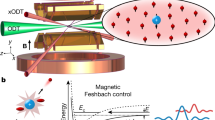Abstract
Neutral atoms trapped with modern laser cooling techniques offer the promise of improving several broad classes of weak interaction experiments with radioactive isotopes. For nuclear β decay, demonstrated trap techniques include neutrino momentum measurements from beta-recoil coincidences, along with methods to produce highly polarized samples. These techniques enable experiments to search for non-Standard Model interactions, test whether parity symmetry is maximally violated, search for 2nd-class tensor and other tensor interactions, and search for new sources of time reversal violation. Ongoing efforts at TRIUMF, Berkeley, and Los Alamos will be highlighted. Trap experiments involving fundamental symmetries in atomic physics, such as time-reversal violating electric dipole moments and neutral current weak interactions, will be briefly mentioned.
Access this chapter
Tax calculation will be finalised at checkout
Purchases are for personal use only
Preview
Unable to display preview. Download preview PDF.
Similar content being viewed by others
References
T. Sumikama, these proceedings.
M. Beck, these proceedings.
D. Rodríguez, these proceedings.
N. Scielzo et al., Bull. Am. Phys. Soc., Div. Nucl. Phys., October 2004, JG.009.
F. Herfurth, these proceedings.
J.C. Hardy, these proceedings.
K. Jungmann, these proceedings.
P. Mueller, these proceedings.
E.L. Raab et al., Phys. Rev. Lett. 59, 2631 (1987).
T.B. Swanson et al., J. Opt. Soc. Am. B 15, 2641 (1998).
O. Kofoed-Hansen, Dan. Mat. Fys. Medd. 28, 1 (1954).
C.S. Adams, E. Riis, Prog. Quantum Electron. 21, 1 (1997).
G.D. Sprouse, L.A. Orozco, Annu. Rev. Nucl. Part. Sci. 47, 429 (1997).
J.A. Behr, Nucl. Instrum. Methods B 204, 526 (2003).
N.D. Scielzo et al., Phys. Rev. Lett. 93, 102501 (2004).
A. Gorelov et al., Phys. Rev. Lett. 94, 142501 (2005).
E.G. Adelberger et al., Phys. Rev. Lett. 83, 1299 (1999); 83, 3101 (1999)(E). After recent mass measurements ã is being re-evaluated (K. Blaum et al. Phys. Rev. Lett. 91, 260801 (2003) and A. Garcia, Nucl. Phys. A 746, 298c (2004)).
M. Trinczek et al., Phys. Rev. Lett 90, 012501 (2003).
T.A. Carlson, Frances Pleasonton, C.H. Johnson, Phys. Rev. 129, 2220 (1963); T.A. Carlson et al., Phys. Rev. 169, 27 (1968).
N.D. Scielzo et al., Phys. Rev. A 68, 022716 (2003).
D.A. Verner et al., Astrophys. J. 465, 487 (1996).
S. Abachi et al. Phys. Rev. Lett. 76, 3271 (1996).
J.C. Hardy, I.S. Towner, Phys. Rev. Lett. 94, 092502 (2005).
P. Herczeg, Prog. Part. Nucl. Phys. 46/2, 413 (2001), and references therein, in particular P. Langacker, S. Uma Sankar, Phys. Rev. D 40, 1569 (1989).
E. Thomas et al. Nucl. Phys. A 694, 559 (2001); N. Severijns et al., to be published in Rev. Mod. Phys.
S.G. Crane, et al., Phys. Rev. Lett. 86, 2967 (2001).
M. Hausmann et al., Bull. Am. Phys. Soc., Div. Nucl. Phys., October 2003, BG.004.
D. Melconian et al., Nucl. Instrum. Methods B 204, 540 (2003); Bull. Am. Phys. Soc., Div. Nucl. Phys., October 2003, BG.003 and to be submitted.
M.A. Rowe et al. Phys. Rev. Lett. 59, 1869 (1999).
S.B. Treiman, Phys. Rev. 110, 448 (1957).
K.W. Miller, S. Dürr, C.E. Wieman, Phys. Rev. A 66, 023406 (2002).
For an overview, see E.N. Fortson, P. Sandars, S. Barr, Phys. Today 56(6), 33 (2003).
S. Sanguinetti, J. Guéna, M. Lintz, Ph. Jacquier, A. Wasan, M.A. Bouchiat, Eur. Phys. J. D 25, 3 (2003).
J. Engel, these proceedings.
N. Scielzo, Bull. Am. Phys. Soc., April 2004, L14.004, and private communication.
H. Wilschut, private communication; J.W. Turkstra et al., Hyperfine Interact. 127, 533 (2000).
J. Bieron’ et al., J. Phys. B 37, L305 (2004).
V.A. Dzuba, V.V. Flambaum, J.S.M. Ginges, Phys. Rev. A 61, 062509 (2000).
S.R. Nuss-Warren et al., Nucl. Instrum. Methods A 533, 275 (2004).
J. Amini, H. Gould, Phys. Rev. Lett. 91, 153001 (2003).
Z.-T. Lu et al., Phys. Rev. Lett. 79, 994 (1997).
W.C. Haxton, C.-P. Liu, M. Ramsey-Musolf, Phys. Rev. C 65, 045502 (2002).
D. DeMille, M.G. Kozlov, physics/9801034.
J.M. Grossman et al., Phys. Rev. A 62, 062502 (2000) and references therein.
J.S. Grossman et al., Phys. Rev. Lett. 83, 935 (1999).
S.N. Atutov et al., Hyperfine Interact. 146–147, 83 (2003).
S.N. Atutov et al., Phys. Rev. A 67, 053401 (2003).
Author information
Authors and Affiliations
Editor information
Editors and Affiliations
Rights and permissions
Copyright information
© 2005 Società Italiana di Fisica / Springer-Verlag
About this paper
Cite this paper
Behr1, J.A. et al. (2005). Weak interaction symmetries with atom traps. In: Gross, C.J., Nazarewicz, W., Rykaczewski, K.P. (eds) The 4th International Conference on Exotic Nuclei and Atomic Masses. Springer, Berlin, Heidelberg. https://doi.org/10.1007/3-540-37642-9_190
Download citation
DOI: https://doi.org/10.1007/3-540-37642-9_190
Received:
Revised:
Published:
Publisher Name: Springer, Berlin, Heidelberg
Print ISBN: 978-3-540-28441-3
Online ISBN: 978-3-540-37642-2
eBook Packages: Physics and AstronomyPhysics and Astronomy (R0)




